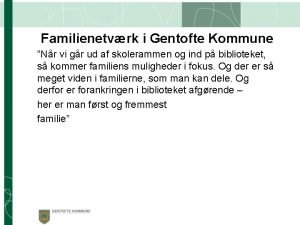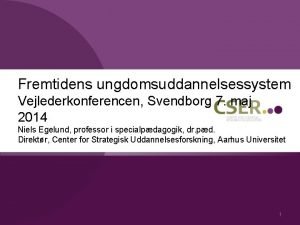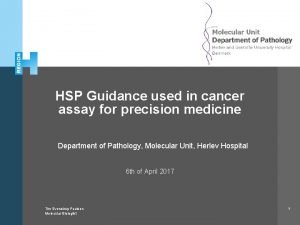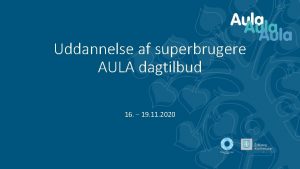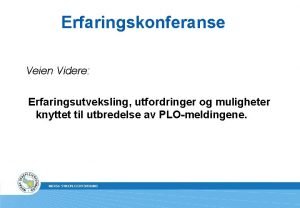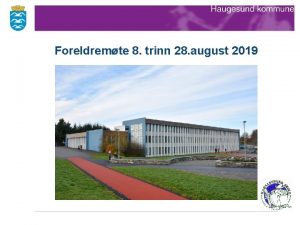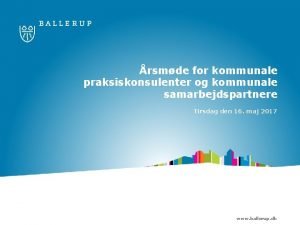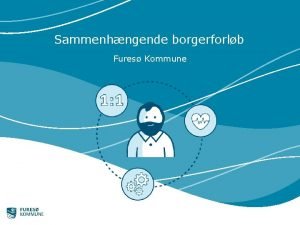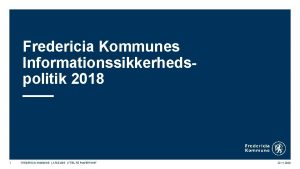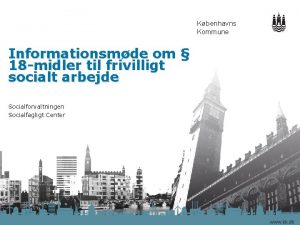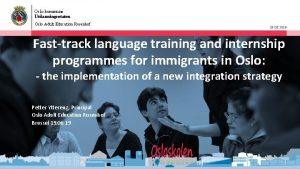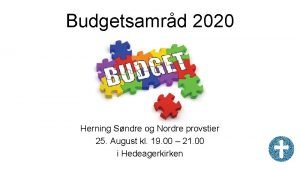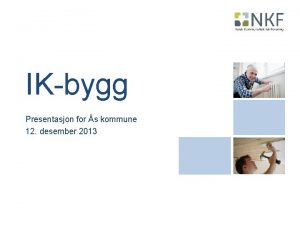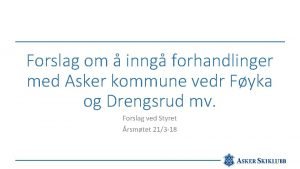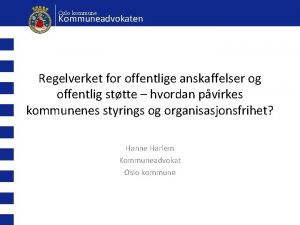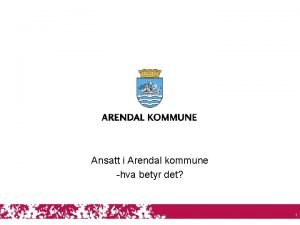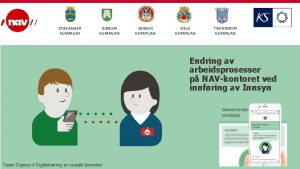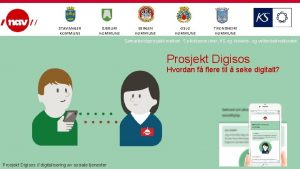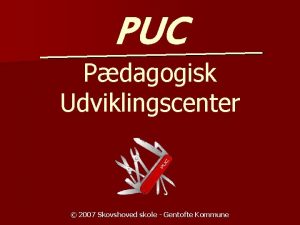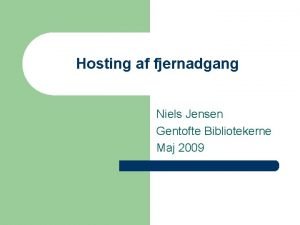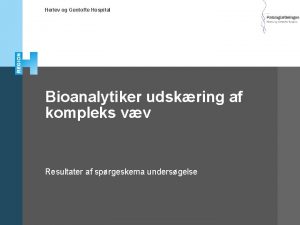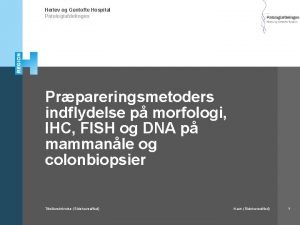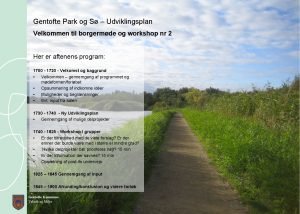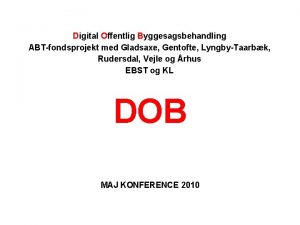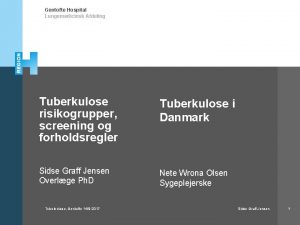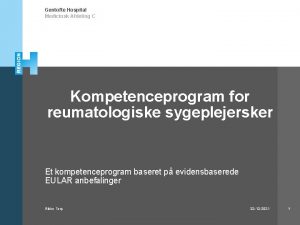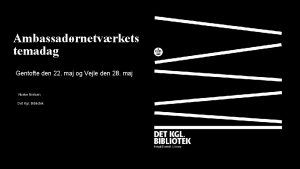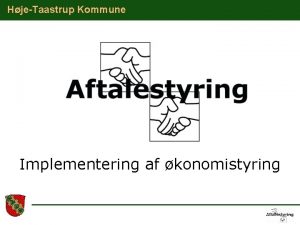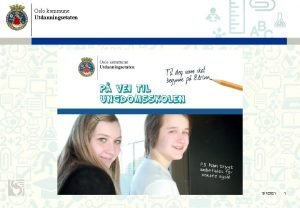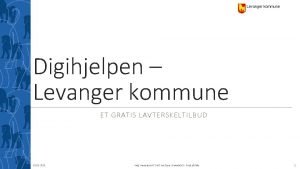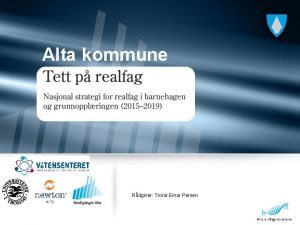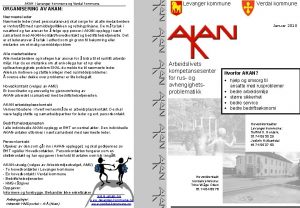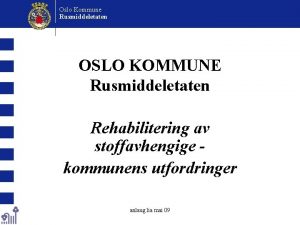Familienetvrk i Gentofte Kommune Nr vi gr ud























- Slides: 23

Familienetværk i Gentofte Kommune ”Når vi går ud af skolerammen og ind på biblioteket, så kommer familiens muligheder i fokus. Og der er så meget viden i familierne, som man kan dele. Og derfor er forankringen i biblioteket afgørende – her er man først og fremmest familie”

Opdraget • Handicappolitikken som den er vedtaget i samarbejde med Handicaprådet i kommunen afsatte 50. 000 til initiativer forankret i kulturtilbud på biblioteket. Projektleder er bibliotekar Marianne Schou Petersen Planlægningsgruppe bestående af undervisere fra Kompetencecenter Dyslexia og læsekonsulenten, samt hjælp fra diverse interesserede.

Formålet Netværket skal fungere som et forum for • Videndeling • inspiration • information • kulturelle tilbud … der understøtter læseglæde og motivation

Familienetværkets møder • Opstartsmøde med Nina og hendes mor (60 deltagere 4. -9. kl)

• Møde om selvværd og om at finde det, jeg er god til med Bubber og Birgit Dilling Jandorf (160 deltagere fra 4. -9. kl)


• Møde om vejledning og kompetencer med Marie Wolter Bertelsen, GKs UU vejleder Bente og Tina, som er leder af den innovative projektopgave og udskolingsforløb i GK (85 deltagere fra 6. -9. kl)

• Information om andre aktiviteter udbudt af biblioteket: Ulvetime, Læsehunde mv.

Input og feedback fra deltagerne • Det er klart, at det ikke er alle, man kan spejle sig i, men man får indblik i de måder, man kan tackle ordblindhed som familie. • Jeg var virkelig glad for, at du mødte os på den måde. • Kunne vi ikke udnytte hinandens resurser? • Kunne man ikke lave noget, hvor…. ?

Positioner • Man bliver ikke bedre til at læse af at spille fodbold! • ”Jeg er Zlatan!” • Vi ved intet om, hvilke kompetencer der efterspørges når vores børn skal ud på arbejdsmarkedet! • ”Læsning er kommet for at blive? ” • Kan vi ikke få en skoleleder til at forklare sig – så giver jeg en flaske cognac! • Jeg synes der er alt for få af de gode historier, for det går virkeligt godt for min søn!


Gentofte Kommune • Elevgrundlag er ca 7500 elever • 11 folkeskoler, 1 specialskole, 6 privatskoler • Hovedbiblioteket og en række lokalafdelinger ifm skoler (og PLC) • Kompetencecenter Dyslexia • 170 elever på ugekurser • 15 elever på helårskursus, specialtilbud • Tæt bebygget kommune på ca 5 x 5 km. • Børn, skole, kultur, unge og fritid er samme opgaveområde i forvaltningen, samme direktør. • Læsekonsulent – Mia Finnemann Schultz

Tilbud til elever med ordblindhed i GK • Knaldgod undervisning på skolerne • 7500 elever • Intensivering i regi af lokale resursecentre på skolerne • Yderligere intensivering i regi af holddannelse, centralt udbudt i regi af læsekurserne på Kompetencecenter Dyslexia • 167 elever i år • Yderligere en mulighed for et helårskursus, specialtilbud (dvs over 9 timer/uge) • 15 elever i år

Kompetencecenterets tilbud • Elevkursus • Opfølgningssamtale med hele lærerteamet • ”Åbent Hus” hvor eleverne underviser kontaktlærere og læsevejledere • Grundkursus i læringsmiljøet, App. Writer og Nota for alle lærere • Lokale workshops • Særlige forældremøder i opstarten med generel info • It-kurser forældre • Ekstern vejledning både på skoler og i hjem

At have det godt • Salutogenesis, a concept developed by Antonovsky (1979), focuses on factors that support human health and well-being rather than on factors that cause disease. Antonovsky suggested that instead of asking ‘what causes illness? ’, an equally or more important question to pose was ‘what is the origin of health? ’ • Antonovsky proposed that the key factor in salutogenesis is a person's sense of coherence (SOC). He defined SOC as ‘a global orientation that expresses the extent to which one has a pervasive, enduring though dynamic feeling of confidence that one's internal and external environments are predictable and that there is a high probability that things will work out as well as can reasonably be expected. ’ • Ingesson 2007, s. 29

At acceptere sig selv – en proces • • • Awareness of difference The labelling event Understanding/negotiation of the disability Compartmentalization Transformation • Reiff et al. (1997) refer to a reframing process, by which they denote a reinterpreting of the experience of disabilities from something dysfunctional to something functional.

De afslappede • The relaxed group comprised the individuals that did not value academic success highly, but revealed a high global self-worth and sense of coherence. All had good peer relations and several were active in sports. Mothers were affectionate and optimistic about their children.

De resignerede – nærmest opgivende • The resigned expressed low selfesteem and feelings of hopelessness in the interviews and scored comparatively very low on both questionnaires.

De hårdt-arbejdende • The strugglers group was by far the largest (50 subjects). All of them thought that their dyslexic problems had affected school accomplishments a great deal and still affected their reading and writing ability considerably. Most of them thought however, that the negative impact on their self-esteem had decreased with time. This had however not been achieved without hard work on their part. A majority had worked very much with their reading, writing and home-work. Early on they had also struggled with feelings of inferiority, but they felt that they had gradually adjusted to their situation.

Vedholdenhed og at høre til i familien • The ten best adjusted in the strugglers group had been very determined in their school work and had received extensive help from their parents. All had a special interest, sport or talent. Describing themselves, the subjects recurrently used the word ‘persistent’. The inspiration to withstand was attributed to the support from families, above all from their mothers. The parents expressed very affectionate relations to their children and positive views about their children’s potentials. A view shared by most of the strugglers (and their parents) was that their dyslexia still influenced their reading and writing but that this was just one of many parts of themselves, i. e. they showed evidence of compartmentalization. • Ingesson 2007

Resultater mshp familiers unikke bidrag • • • The persistence that the subjects and their mothers identified as one of the roots of well-being indicates an internal locus of control, i. e. the subjects felt it was their own responsibility to deal with their difficulties. The internal ‘locus of control’ together with persistence was thought to develop from their families’ support especially their mothers’ positive views about their children’s potentials. Acceptance and compartmentalization of the disability was a general positive factor. The subjects’ experience of parental support and mothers’ belief in their capacity together with good peer relations were factors that most certainly were important for adjustment. There was no relationship between mothers’ educational level and the amount of help and support that they had offered. A solid interest, like sports and scouting, or a niche such as arts and computers were other important salutogenic factors. Choices of school programmes and employment consistent with the subjects’ strengths and talents were another essential positive aspect.

Gunnel Ingesson, 2007, Salutogenetiske faktorer • In Study III, the first of its kind in Scandinavia, the purpose was to uncover factors important for a favourable socioemotional outcome, so-called salutogenic factors. The subjects and parents were interviewed. Subjects’ global selfworth and sense of coherence were measured. Dyslexia was found to be a risk factor for low global self-worth when associated with poor peer relations and low parental support, typical for a group of ‘resigned’ subjects. External salutogenic factors were; having significant others who believe in the subjects’ capacity to cope with the situation, together with good peer and family relations, and having a hobby or being good at sports. Important internal factors were a special talent, the ability to compartmentalize the disability and a personal trait of persistence. The emergence of the latter was discussed.

• The salutogenic factors that emerged through the interviews with the subjects with a high SOC and global self-worth were; having a niche, such as sports, social activities or a special interest or talent where they did well and which made them view themselves positively. Support from family, particularly mothers, and having good friends were very important too. The internal factor of being persistent was a frequently mentioned characteristic. Also, it was obvious that many of them had succeeded in compartmentalizing their difficulties so that the problems involved in being dyslexic did not overshadow their self-image. (s. 55)
 Gentofte kommune skoler
Gentofte kommune skoler Gymnasial suppleringskursus gentofte
Gymnasial suppleringskursus gentofte Herlev and gentofte hospital
Herlev and gentofte hospital Gentofte hovedbibliotek
Gentofte hovedbibliotek Eknet esbjerg kommune
Eknet esbjerg kommune Grandgården legesenter
Grandgården legesenter Organisasjonskart bodø kommune
Organisasjonskart bodø kommune Hvaler kommune
Hvaler kommune Skooler haugesund
Skooler haugesund Tobs skema
Tobs skema Sammenhængende borgerforløb
Sammenhængende borgerforløb Informationssikkerhedspolitik
Informationssikkerhedspolitik Brum kommune
Brum kommune Fernando guarino
Fernando guarino Paragraf 18 københavns kommune
Paragraf 18 københavns kommune Petter yttereng
Petter yttereng Thisted kommune teknisk forvaltning
Thisted kommune teknisk forvaltning Nordre kapel herning
Nordre kapel herning Ik bygg kommune
Ik bygg kommune Asker kommune reguleringsplan
Asker kommune reguleringsplan Esbjerg kommunes biblioteker
Esbjerg kommunes biblioteker Fysio ergo stavanger kommune
Fysio ergo stavanger kommune Kommuneadvokaten oslo
Kommuneadvokaten oslo Arendal kommune ansattportal
Arendal kommune ansattportal
